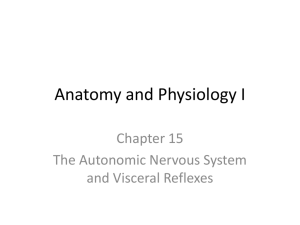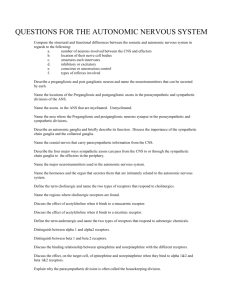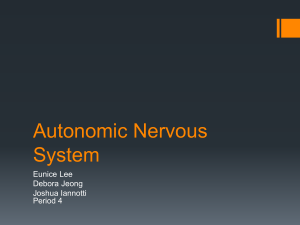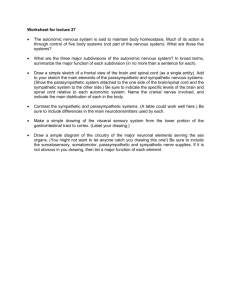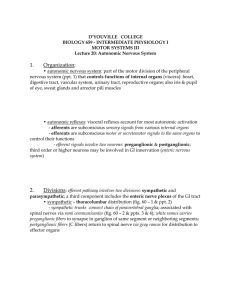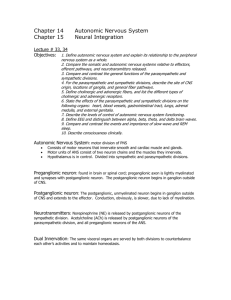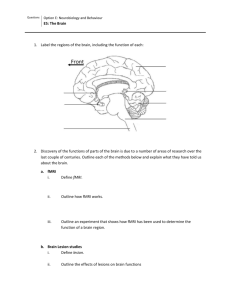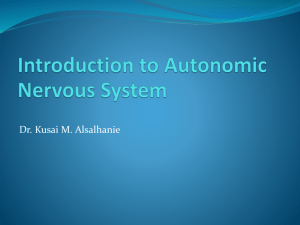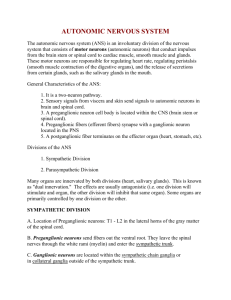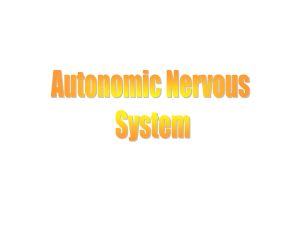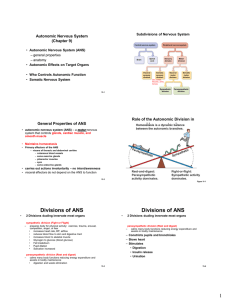Lecture6 & 8
advertisement
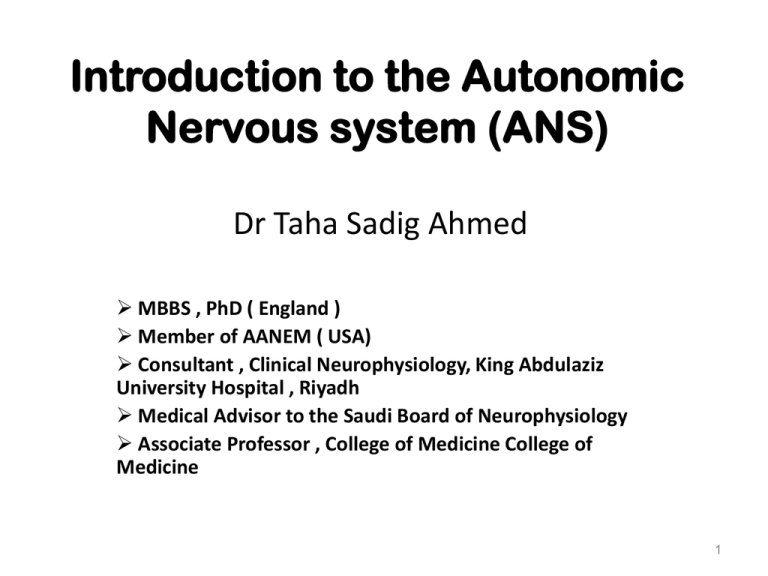
Introduction to the Autonomic Nervous system (ANS) Dr Taha Sadig Ahmed MBBS , PhD ( England ) Member of AANEM ( USA) Consultant , Clinical Neurophysiology, King Abdulaziz University Hospital , Riyadh Medical Advisor to the Saudi Board of Neurophysiology Associate Professor , College of Medicine College of Medicine 1 • ANS has two subdivisions: • Sympathetic and Parasympathetic • Higher control of the ANS is by Hypothalamus : • Posterior hypothalamus controls Sympathetic NS • Anterior hypothalamus controls Parasympathetic NS 2 Sympathetic NS • • Sympathetic system is active during stress and activity , such as physical exercise ( as in sport ) ; and during increased mental & emotional activity such as in worry , anxiety, fear , anger , severe pain preparing the body for action fight or flight to defend itself by attack or to escape from danger Its activation promotes mechanisms which increase energy production , accelerate metabolism . 3 Parasympathetic NS • Parasympathetic system activities is related to the relaxed state , rest and anabolism • It promotes vegetative functions ( nutritive , body-building , restorative functions & tissue repair ) • It is more active during feeding , digestion & rest & sleep . 4 The Autonomic Outflow consists 2 Neurons neurons arranged in series: •Preganglionic nerves : arise from the spinal cord in case of sympathetic sytem ( + brain & spinal cord in case of parasympathetic system ) .Postganglionic nerves : arise from ganglia . 5 (1) Preganglionic nerves in the sympathetic system exit the CNS from the thoracic and lumbar segments of the spinal cord . Therefore , the sympathetic system is also called : “ Thoracolumbar Outflow “ 2) The preganglionic sympathetic fibers are shorter than the postganglionic fibers (1) Preganglionic nerves in the parasympathetic system exit the CNS from the cranium and sacral segments of the spinal cord . Therefore , the paraympathetic system is also called : “ Craniosacral Outflow “ 2) The preganglionic parasympathetic fibers are longer than the postganglionic ones . Sympathetic (Thoracolumbar) System 1. The preganglionic neuron cell-bodies are located in the CNS 2. Preganglionic fibers are myelinated 3. The postganglionic neuron cell-bodies are located in sympathetic ganglia , distant from their target tissues . 4. Postganglionic fibers are unmyelinated & longer than preganglionic fibers . 5. There is greater divergence . The ratio (pre/post) being = 1/10 ; 6. This divergence implies diffuse ( generalized ) actions . 8 Parasympathetic (Craniosacral ) system 1. The preganglionic neuron cell-bodies are located in the CNS 2. Preganglionic fibers are myelinated 3. The postganglionic neuron cell-bodies are located in parasympathetic ganglia , close to their target tissues or embedded in their walls 4. Postganglionic fibers are unmyelinated & shorter than preganglionic fibers . 5 . There is little divergence , the ratio of pre- to postgaglionic fibers is 1/3 . 6. This little divergence implies more specific , localized actions . Effect of sympathetic & parasympathetic stimulation Organ sympathetic parasympathetic Pupil of the eye -------------------------Glands Salivary Nasal Lacrimal Gastric Pancreatic -------------------------Blood vessels Dilatation of pupil ---------------------------Slight secretion Constriction of pupil ---------------------------Copious ( larger ) volume ---------------------------Constriction ---------------------------Little or no effect Effect of sympathetic & parasympathetic stimulation Organ sympathetic parasympathetic SA node Increased heart rate Decreased heart rate Myocardium ( Cardiac muscle ) --------- -------------Lung ----------------------- Increased force of contraction ---------------------------Dilatation of bronchioles No effect on force of contraction ---------------------------Constriction of bronchioles ---------------------------(1) Increased motility + relaxed sphincters( therefore promotes emptying ) + (2) Increased secretion ---------------------------Anabolism dominates Heart Gastro-intestinal tract ( GIT) -----------------------Metabolism ----------------------------(1) Decreased motility+ constricted sphincters (therefore promotes retention ) + (2) Decreased Secretion ----------------------------Increased metabolic rate + catabolism dominates Effect of sympathetic & parasympathetic stimulation Organ sympathetic Lung Dilatation of bronchioles ------------------------ ----------------------------Urinary bladder Decreased urine secretion ------------------------ -----------------------Increased metabolic Metabolism rate + catabolism dominates -------------------------------------------Blood Pressure Raised -----------------------------------------Blood Sugar Raised parasympathetic Constriction of bronchioles -------------------------Increased urine secretion ---------------------------Anabolism dominates -----------------------Little or no effect --------------------------- Little or no effect •Thanks !

